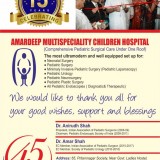What is duodenal atresia?
Duodenal atresia means the duodenum (first part of the small intestine just beyond the stomach) is closed off rather than being a tube. This stops food and fluid passing from the stomach into the intestines.
How is it diagnosed?
Duodenal atresia can sometimes be discovered during pregnancy as it often shows up on antenatal ultrasound scanning. Some babies with this condition are born prematurely. Many babies appear well at birth but when they start to feed, they are sick and their vomit is green. An X-ray scan can confirm this diagnosis.
Duodenal atresia is a rare condition and occurs in about one in 10,000 births. It can be associated with other problems, so the doctors will examine your child closely to check if this is the case. One third of all children with duodenal atresia have Downs’ syndrome.
How is it treated?
Duodenal atresia is repaired in an operation under general anaesthetic (so your baby is deeply asleep), which lasts around 1 – ½ hours.
Are there any alternatives?
No. Duodenal atresia always requires treatment to allow your baby to feed.
What happens before the operation?
Your baby will need admission in hospital. To begin with, your child will be nursed in a warner and will have a naso-gastric (NG) tube passed through his or her nose into the stomach. This will drain off the contents of the stomach and stop your child from vomiting. It also releases any excess air from the stomach, which could make your child uncomfortable. He or she will also have an intravenous infusion (drip) of fluids and medicines.

What does the operation involve?
The surgeon will cut the blind end of the duodenum and connect it to the rest of the intestine. This provides a clear passage for food and fluid to travel from your child’s stomach to his or her intestine.
What happens afterwards?
Your baby will return to the ward to recover. All babies are closely monitored after the operation, and so your baby will be connected to monitors to check his or her breathing, heart rate and oxygen levels. He or she will also be given pain relief through the intravenous infusion (drip).
While your child’s intestines recover and start to work, he or she will be fed through a tube into his or her veins. This will gradually be replaced by breast or bottled milk, given through the naso-gastric tube when your child is able to tolerate this. As your baby recovers, you will be able to feed him or her from the breast or bottle.
You will be able to go home once your baby is feeding properly and gaining weight.




